Published by Jeremy. Last Updated on February 7, 2023.
Disclaimers: Our site uses demographic data, email opt-ins, display advertising, and affiliate links. Please check out our Terms and Conditions for more information. Listed prices and attraction details may have changed since our visit and initial publication.
For our first time trekking, we choose what is considered to be one of the most strenuous: Mount Everest Base Camp.
When purchasing our gear in Kathmandu, we had no real idea what we were needing and had to rely on a number of packing lists found online (this one from our friends at The Planet D was a pretty good start).
As we had no clue of our own abilities, we bought pretty much everything recommended for an Everest Base Camp Trek packing list just to cover us in case we needed them.
After successfully completing the trek, and managing it in relative ease, we wanted to look back at some of the more notable items in our packing list to comment on their need for those who may be in a similar position to us.
This post will not include everything we took, but instead focuses on some of the more unique items that a trekking packing list often includes.
Disclaimer: Please keep in mind that our trek was in late-November 2013. We cannot comment on how this packing list would work in the summer or winter months as we do not have personal experience hiking in these conditions.
✈️ Book Your Next Trip
- • Planning a trip? Find a flight deal.
- • In need of a room? Check out hotel and apartment prices.
- • Taking a cruise? Find a cruise itinerary for your journey.
- • Don't overlook picking up a rental car or day tours as well!
Reviewing Our Everest Base Camp Trek Packing List
Hiking Poles – YES
We each had two hiking poles, and used them extensively on both the uphill (when exhausted) and downhill walking days. If you are used to hiking you may get by with just one, but we recommend having two just in case.
The paths themselves are relatively well maintained, but there are some parts that are quite steep and, coupled with exhaustion, benefit greatly from having the poles.
As we were traveling in November and snow was a possibility, we think having two poles is quite worth it.
Down Jacket, Fleece Hat, Gloves (thin and thick), and Fleece Tops/Bottoms – YES
The coldest part of the day is not during the trek itself, but the periods between sleeping and walking (breakfast and dinner time). The heaters are not very efficient and nights can get incredibly cold, so this gear was most used then.
With this being said, the trekking segments above Dingboche at the highest elevations may require a few of these layers to be worn in the mornings and at the end of the trek, and you will likely strip down to a t-shirt as the day heats up.
For those who get very cold, we recommend having a good pair of thick gloves for the very cold days.
Our off-brand gloves did not quite cut it and I had a day of particularly cold fingers in the morning that I would never like to experience again.
Down Booties – Maybe
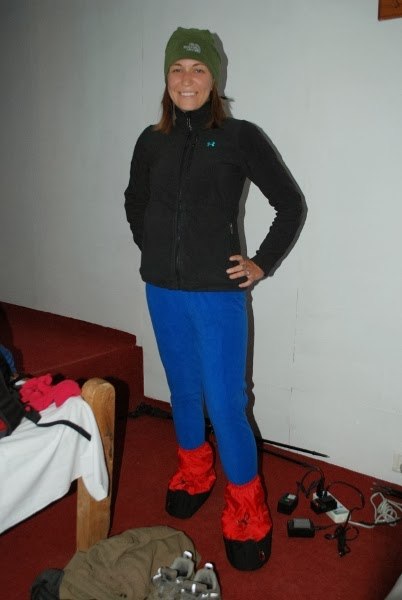
Everyone who hikes on the Everest Trek in the colder season seem to swear by down booties to keep their feet warm at night.
We hardly found them to purchase in Kathmandu and instead had to wait until Namche Bazar to buy them (where they were plentiful).
These booties are essentially the same as your down jacket, but for your feet. Overall they did keep our feet warm, and were great to wear in the tea houses in the evening when it is cold. However, we found that our feet took quite a long time to warm up in the down material so we were cold for a bit until that happened.
If you are prone to getting cold, then they are worth it. Otherwise a good pair of thick socks may be enough.
Gaiters – NO, Within Reason
During our stay, we had no reason to use gaiters.
There was no snow, the streams were low, and our waterproof shoes did the trick enough to keep us protected.
With that being said, there was snow just a few weeks before we were there, and the weather is always different. For something so cheap, it is a good insurance policy to have just in case. (And speaking of insurance, be sure to pick yours up at World Nomads before you go- you may need it here!)
-20C Rated Sleeping Bag – YES
We rented a sleeping bag for roughly 100 Rupees per day each, and were happy with our choice to get a -20C rated sleeping bag. We only got near that temperature at the highest stop (Gorak Shep), and at the lower elevations found ourselves sleeping in only a t-shirt and shorts while in the bag.
Off-brand sleeping bags are said to provide about 10C less resistance than their published rating, mostly due to poor workmanship, but we had no issues with ours at this time.
Please keep in mind that these thick bags are quite large when packed up, much more so than your normal sleeping bag you’d use at home.
The photo at the beginning of this post illustrates this perfectly as the larger rolled up cases are the sleeping bags and the smaller rolled up cases are our down jackets.
Nalgene Water Bottle, Metal Water Bottle, and Chlorine Tabs – YES
You will need two water bottles on this trek. A Nalgene for drinking cold water (purified with chlorine tabs) and a metal water bottle for night time.
Fill your metal water bottle with hot water before bed and toss it in your sleeping bag to stay warm.
We had gone through about 5 metal water bottles on our trek because a few broke during the day or did not seal properly (check this carefully before buying).
As you will be keeping hot water in this, it is important to have a metal one as your nalgene or camelback may not seal properly at those temperatures. In fact, we met a guy who ruined his camelback by putting boiling hot water into it, thus getting it all over his down sleeping bag in the process.
When choosing a bottle for hot water, do not buy a double lined one that is normally used for coffee. It will retain the heat far too well and not heat up your sleeping bag properly. A basic metal bottle is best and will last for most of the night.
Head Torch – YES but Possibly 1 Per Couple
At the higher elevations the tea houses typically run on solar power. This means that their electricity is limited and may often only run for about 2 hours after dark (around 6-8pm).
After that there is absolutely zero power, lighting, or anything else that would help you get around (and more importantly, find a toilet to flush out all that water you’ve been drinking).
Unless you want to hike up to Kala Patthar or another large mountain that requires an ascent in the morning or after sunset, you may only need one head torch if traveling as a couple and trying to save money.
The only two cases where having two is worth mentioning is 1) if you want to read in your room at night as even when the electricity is on the lighting is often poor, and 2) if you go at another time of the year when the hours of daylight are even less.
For us, we were happy to have two, and would recommend that for all traveling couples.
Warm Jacket – YES
Our Under Armour Muroc Jackets were something we wore quite a bit when the day warmed up but was not quite too-hot or too-cold. They were not the most wind resistant, which is something that is often highly recommended, but we found that we did not need that feature during the hike.
Out of all the stops on the trek, the Periche Valley is by far the windiest. We opted only to walk through on our way back and instead plow our way to Tengboche, so we were never there in the early/late hours to see how much worse it got.
If other times of the year are reported to be any windier, I may recommend a better jacket, but in late-November we did not see the need in the slightest.
Tea and Tang – NO to Tea, YES to Tang!
We bought enough tea and Tang in Kathmandu to allow us to have a large amount of each for the whole trek. As we quickly found out, our meal plan from our guide included tea so we did not have to use any we brought with us.
Even if the meal plan did not include tea, you have to pay for hot water which would make taking tea impractical unless you are a die hard tea drinker while walking and need a liter or more at a time.
As for Tang, we think it is an essential. After walking for 4-5 hours before lunch, and sweating a lot in the lower altitudes, you need to replenish some sugar and Vitamins.
Not only that, drinking 4L+ of plain water for 12-days straight is boring. Mixing in a liter of Tang water after a long day of trekking helped us considerably.
Just be careful, however, as you should not drink Tang until later in the day when your body starts craving the sugars.
Angie drank one first thing in the morning and never felt thirsty during the day. By the end of that particular hike she had not drank enough water and got a severe headache that we thought could be AMS.
But as many others report, a headache is incredibly common when you don’t drink enough water, and may not be AMS but rather dehydration, so don’t take any chances!
Keeping the Cost Down
Overall, we were very happy with our packing list for the Everest Base Camp trek and used just about everything that was in our bag.
For having bought it all in Kathmandu (with few exceptions) and resold it all for 50% back after we returned, our final out-of-pocket spending was minimal at around $110 per person, or around $8/day.
So although we may not have needed those $5 gaiters or used our $15 head torches as much as I would have liked, the extra $10 after selling back was not worth troubling ourselves over if a bad scenario had required their need.
No matter what you decide to take, be careful when you pack.
Forgetting an item that may save you (or your comfort) in an emergency just to save a few dollars is not a risk worth taking, and since the weather changes frequently you’ll never truly know what may come your way on the trek.
Cover yourself, buy a bit extra, and enjoy Everest Base Camp!
About Jeremy
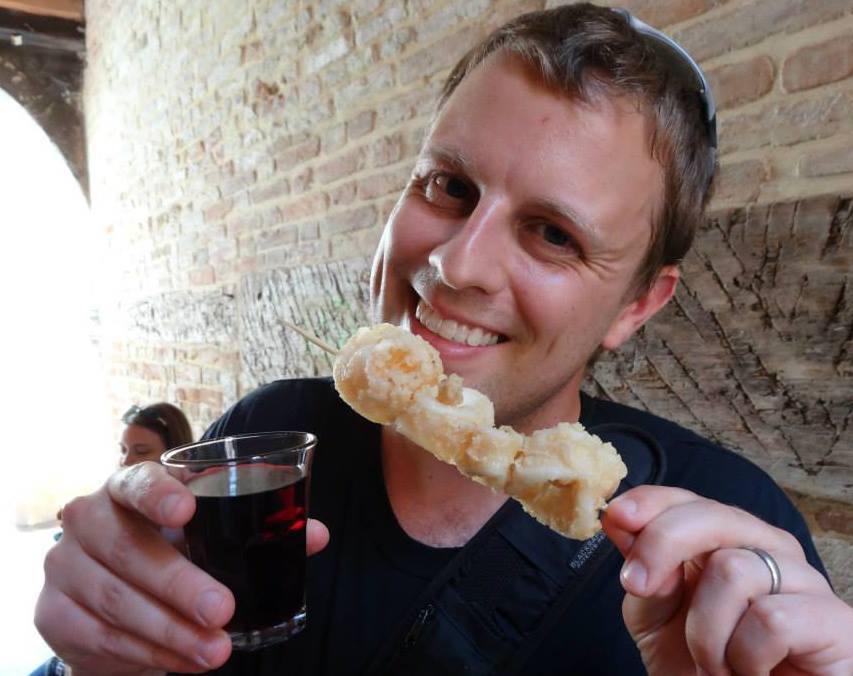
About the Author: Jeremy is a full-time travel writer based in Pittsburgh and primary author of this site. He has been to 70+ countries on five continents and seeks out new food, adventure activities, and off-the-beaten-path experiences wherever he travels.
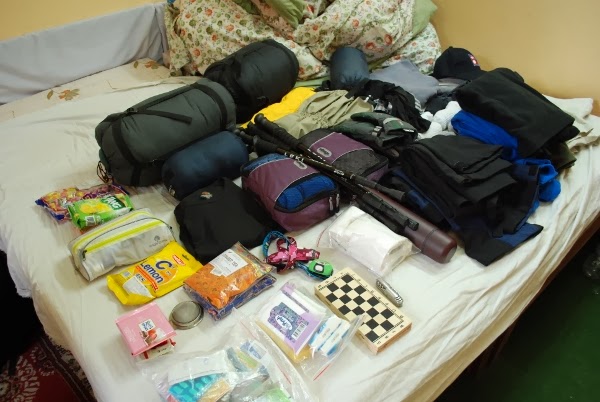
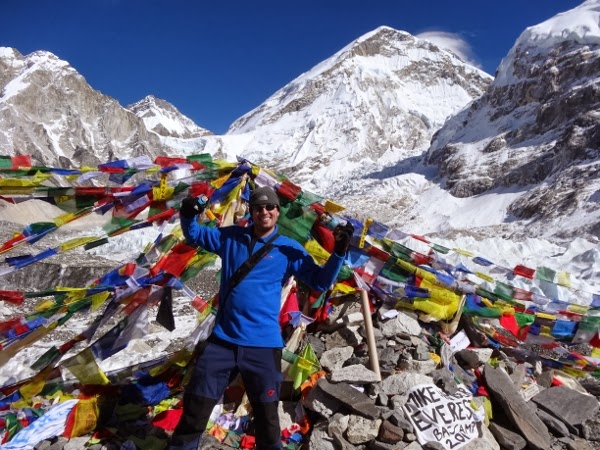
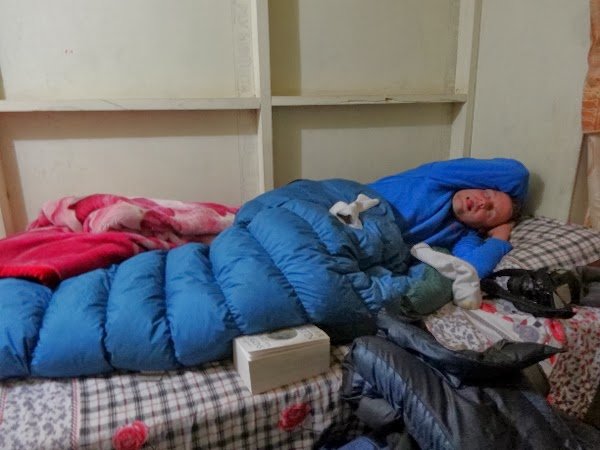
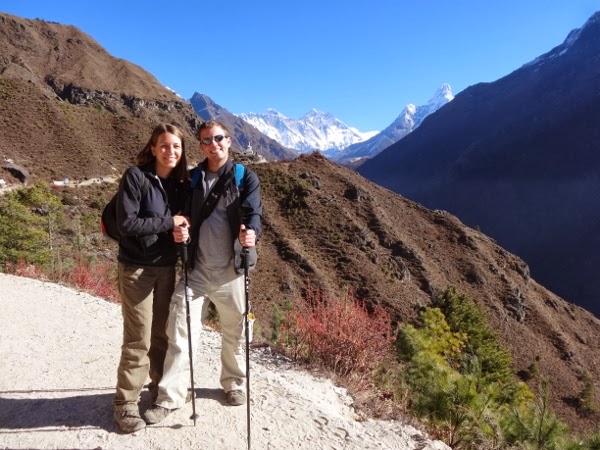
I’m in Kathmandu now, end of September, leaving in a few days. It’s stinking hot here and about 20 degrees in Lukla. According to all the weather forecasts there is nothing even close to minus 10 C at night right up to EBC. We’re well used to low temps having spent the last 2 winters in Romania at minus 20 C so I’m really doubting we’ll need a sleeping bag. Last time we went up it got to about minus 10 C and we didn’t take bags, just used the blankets provided and were fine. It’s a really tough call to make. It’s not about money, it’s about the weight and bulk of carrying the things. That said, on the Annapurna circuit in February HELL YEAH! We needed sleeping bags ( and gaters in deep snow). I think we’re just going to take our regular liners, which we always carry and fleece liners plus tea house blankets. From your pic above of you not even in your bag, I’m like…yeah, you didn’t need that. But it’s doing my head in, such a tough call to make. For reference in Romania we just slept under very ordinary duvets, but of course had plenty of clothes and hats on and it was zero in the bedroom. I was only ever a bit chilly once it got below minus 17 or so. Presumably you had a porter so didn’t worry about weight? We’ve never used a hot water bottle either. We have one 4 season bag with us. Maybe we’ll just rent 1 and then the kids will have a sleeping bag and we adults will be fine. But we don’t want to weigh ourselves down that makes everything so much harder and we don’t need porters of guides. Just can’t decide, thinking aloud on your site. What do you think?
Hi, thank you for the atricle it is really helpful. I am wondering if my Millet 700 fill power 450 gr. down sleeping bag will be sufficient in your opinion for a base camp trek in November it is: Comfort temperature : 1°C Limit temperature : -5°C Extrem temperature : -22°C.
I am not an expert, but I think you would probably be fine. The knock-off stuff in Kathmandu is said to be rated -20 but is more like -10 or worse. I think if it has the extreme temperature rating of -22 you’re going to be okay. Just be sure to fill a hot water bottle and throw it in the bottom to keep your feet (and batteries!) warm.
Hi ! I really liked your article. I’m very confused about the sleeping bag. The “-20” is Comfort temperature, Limit temperature or Extrem temperature ?
We are going for the same trekking in March/April and I have no idea which sleeping bag I should have.
I never realized there were different ratings. In Nepal I think it is all just one temperature rating for advertising purposes, haha. Assuming the whole Nepal logic of “knock 10 degrees off the rated value for fake brands” was true, then you should plan for the limit temperature being the actual lowest you’ll likely see. We bought a -20 rated bag, which was probably more like -10 since it was probably fake and we were fine at -20 with a hot water bottle in the bag at night and several layers.
Thank you for your response. I have one more question – Is the down jacket really necessary ? Warm fleece + some thermal long sleeve won’t do the tric ?
I don’t know much about the down jackets.. how warm was yourse ?
It depends on how cold it gets at night when you’re going. It gets very cold in the guest houses at higher elevations so if it is sub-zero temperatures I’d recommend getting a down jacket. We bought ours in Kathmandu and I have no idea about the rating of it, sadly.
Great website! I’m doing EBC March 2016 and really enjoyed reading about your experience. My trekking company suggested a 0 degree bag, but I’m going with -20 as you suggested. I live in Florida, so I’m cold just thinking about it already!
Hi Jeremy,
I did the trek around November 2013 too and i can confirm everything you’ve written in this article! I agree, you don’t need everything suggested by some people however on the really cold nights close to base camp you thank your lucky stars you have some warmth!
We are heading to Nepal shortly to complete the Annapurna circuit so we’ll be using this as our packing guide (and a few learnings from the Base Camp trek).
Cheers
The Common Wanderer
Great article, thank you! I am in Nepal now and will be doing EBC at the end of January. I am curious as to where you purchased your gear in Kathmandu and where you were able to sell it back to? I’m assuming in Thamel but woneeding if you remembered any specific places? Thanks!
I think we went to Mount Everest Equipment Store in Thamel. It is located just south of Pilgrim’s Book Store on the opposite side of the road near the intersection (street dead-ends there). You need to press them on the buyback and maybe get it down in writing too that it’ll be a certain percentage if the gear is in good condition.
Heading there in April and still abit unsure on how much to pack this article helped me heaps though. Thanks guys
Did you bring any suntan in november? we will be there in dec-jan.
Thanks for the gear advice!
Yes we did. I don’t think we ever leave home without it